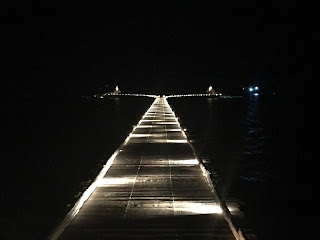| https://youtu.be/GdhHoGkNDkk |
The crossing to Lembongan was uneventful , except for the amazing current lines we encountered. The difference in a 50m width of the Selat Badung meant a speed of 3 knots or 9knots, all whilst heading in exactly the same direction.
Lembongan, only 12
miles across from Bali, from the anchorage looked ok. We picked up a
mooring buoy for the evening and from there we could watch the
surfers on two different breaks, and spotted some late afternoon
stand up paddlers in the bay to our starboard side. The island seems
to be chockers with resorts, and the whole area is supposed to be eco
tourism orientated, although how that can be when one of the major
thrills and spills is para gliding behind speedboats I'm not sure.
 |
| sunset at Lembongan |
Ours was only an
overnight stop,but before we departed from which ever day trip boat
mooring we had adopted for the evening, I checked out under the hulls
in the once again, incredibly clear water. This was the first time,
I've been in the water since the close encounter in the middle of the
night with the bamboo pole. Both Bali Marina and Serengan were to my
mind out of the question for getting in to the briny to take a look.
Damage count,
thankfully minimal. Scuffing to the anti foul around the rubber boot
of the sail drive and loss of antifoul from rudder blade. Amazing
build up of duckweed but no barnacles, and some tiny wee little pippi
like growths attaching themselves here and there towards the water
line and particularly in the sail drive intakes.
After that we set off
northwards to Gili Air. The Gili group sits just on the NW corner off
Lombok.
We have worked out a
series of potential anchorages, at what we now have deemed is a daily
“do able” daylight distance, allowing for ferocious currents and
no wind. Each anchorage needs to be made well before
sunset, especially if there are fringing reefs to be negotiated. Once
having arrived at an anchorage its easy to find ones way out again
,even in the dark if necessary just by following the inbound course
in reverse, so I have no objection to early starts, its just late
finishes which are to be avoided at all costs.
Having read all about
the currents in the Lombok Strait, we set course back to the NW
towards the coast of Bali, using the current to our advantage. Just
about a third of the way from the top of the island we tacked again
and headed across the Lombok Strait, judging that by then the current
would be heading North . It runs South far longer and stronger than
when it runs North, which it does for about 6 hours a day. The wind
had increased substantially by then as well and we had a terrific
sail into Gili Air, where we picked up another mooring for the night.
 |
| Track around the top of Bali on the way to Bali and track from Bali to Lembongan then back towards Bali before turning for Gili Air |
Ashore the place was
full of young mainly Europeans, either I guess ,divers or surfers.
There isn't really a road, just a wide-ish path capable of allowing
pony and traps to travel along. The other mode of transport is
bicycle or foot. We had diner at a foreshore establishment ,watching
the constant stream of movement as the tourists passed us by, coming
or going from the bars and other eating establishments. What was
noticeable (comment worthy in fact), was that there were groups of
young women, there were couples, but oddly we saw no groups of young
men . The information book we had ,says that of the three islands
here, Gili Trawangan is the party island, Gili Meno the quiet island
,and Gili Air has a mixture of both, perhaps the young men prefer
Gili T?
On the way to Gili Air,
we apparently lost a shackle holding the anchor bridle on the port
side. The only other shackle on board that would fit, was at Peter's
brilliant suggestion, lying idle on the boom, where it should have
been attached to the the now useless clew ring of the main. We
removed it from the boom and installed it on the bridle and then
moused both the port and starboard shackles. Mousing for those who
don’t know, is the act of fastening the shackle pin in place with
in the good old days of pre plastic, nautical type seizings and wires
(depending on the size of the shackle).To be honest , electric cable
ties work well, but they do perish, especially in the conditions up
here. These shackles pins have been wired in with e a bit of handy
fencing wire, I just happen to have packed into my suitcase on one of
my return trips to the K'Gari. After all, a girl never knows when a
small coil of fencing wire will come in handy!
 |
| Leaving Gili Air. This is the Eastern side of the island- just a few resorts as you can see. |
Sailed on to Gili Lawang, nothing to write home about , but an anchorage in a depth of about 8m in black sand. Once the appalling music being played by the local fishermen was turned off , the night was a peaceful one.
 |
| The island of Lombok on the way to Gili Lawang |













































